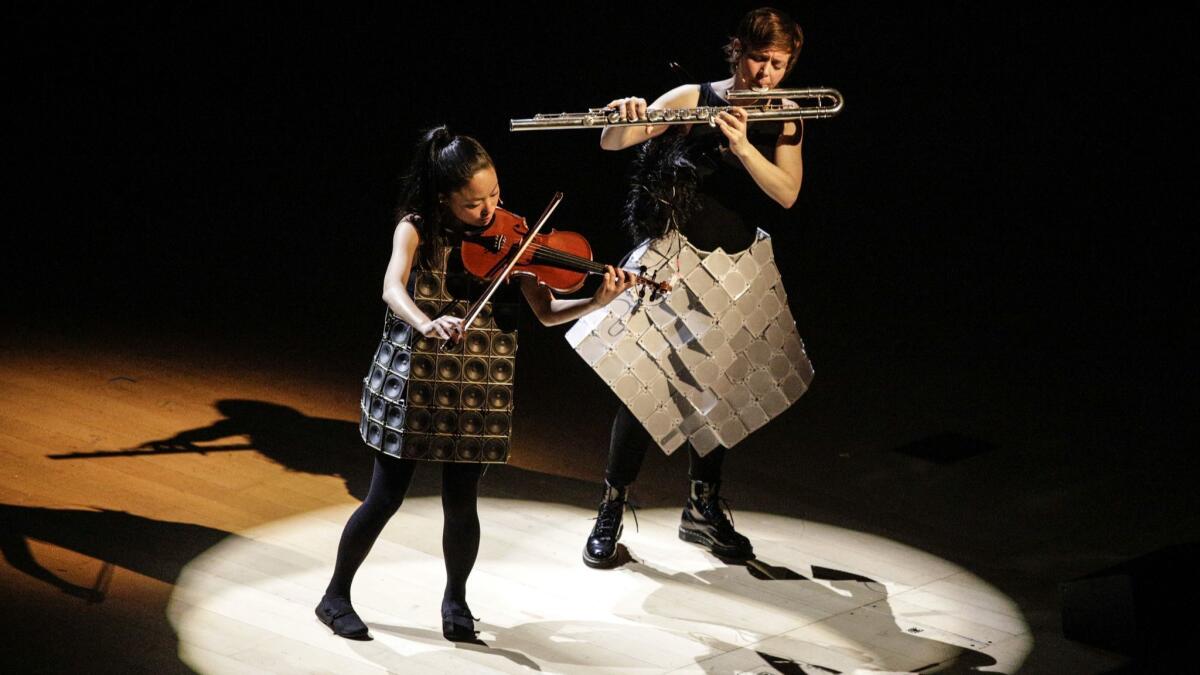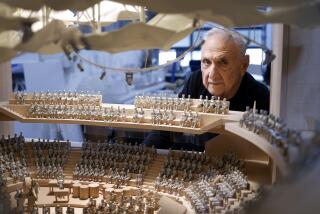Review: At Disney Hall, the dresses made of speakers were just the beginning

The latest in wearables reached a runway at Walt Disney Concert Hall on Tuesday night. We heard them before we saw them. In the darkened theater, designer Pauchi Sasaki walked down the right aisle in her trademark black Speaker Dress I, while the model and flutist Claire Chase sported Speaker Dress II, a skirt with its tiny, thin speakers patterned like an Issey Miyake bag.
For her number Chase also had the ideal accouterment, a flute of intricate plastic tubing that looked as if it took its inspiration from a cow’s intestine. Amplified, it sounded pretty much like what you might imagine a music derived from blowing through a cow’s intestine, not at all unpleasant but interestingly eerie.
As the two performers reached the stage and took up real flute and violin, a vortex of computer graphics were projected over the organ pipes and rear seats. The hall was awash in engulfing instrumental and vocal sounds, processed through live electronic manipulation.
Sasaki’s “Gama XV: Piece for Two Speaker Dresses” may or may not be a game-changer, but it works brilliantly on all levels. Who knows? One day when there are cheap knockoffs of speaker clothing, we might get a whole new kind of immersive music-making. Think about it: an opera where each spectator becomes a vibratory sonic presence.
Indeed, those who bought tickets for this event more than two weeks ago and hadn’t bothered to look at the program might well have thought they were witnessing the beginning of yet another avant-garde opera. This was to have been the premiere of Ted Hearne’s “The Place,” for a Green Umbrella concert by the Los Angeles Philharmonic New Music Group and conducted by Gustavo Dudamel. That opera is a commission with the Barbican in London, and the L.A. Phil was to bring it there next month as part of an upcoming tour.
But the project isn’t quite ready. It will now have its premiere at the Brooklyn Academy of Music, the third commissioner, in the fall. Fully booked up next season, the L.A. Phil is looking at fall 2019.
Fortunately, the orchestra is well experienced at thinking fast to come up with new programs for late commissions. The commanding young baritone Davóne Tines, on hand for performances of Beethoven’s Ninth Symphony this week, was employed to be the speaker in Frederic Rzewski’s “Coming Together” and “Attica,” a stirring response to the 1971 prison uprising. An earlier work by Hearne for string orchestra, “Law of Mosaics,” completed the program.
“Coming Together” sets an eloquent letter by Samuel Melville, a prisoner killed in the rebellion. It’s read slowly and carefully, over a Minimalist background for any ensemble (here 10 players). “Attica” uses the words of another prisoner: “Attica is behind me.” The accompaniment this time is more lyrical and more dominant than the text.
Tines read the first text like a great orator, every word seared. For the second he intoned the words as though they were the atomic structure of a spiritual. Both were simply breathtaking.
Hearne’s “Law of Mosaics” is its own coming together and coming apart. The composer, who teaches at USC, is best known for vocal works that also have a strong political impetus, such as “The Source,” an oratorio about Chelsea Manning that Los Angeles Opera staged in 2016. He was Pulitzer Prize finalist this year for “Sound From the Bench,” a choral piece that uses text from the Supreme Court’s “Citizen’s United” decision. “The Place” will concern gentrification.
The six movements of this 2012 string suite are more abstract but still transgressive. The instruments are amplified with contact microphones, and their job is to twist earlier music into new shapes, maybe not so unlike making a speaker dress.
One movement significantly slows down “climatic moments” from Vivaldi’s “The Four Seasons” and Barber’s “Adagio for Strings,” while laying them on top of each other. Overly familiar music becomes unrecognizable and loses all sentiment. Later in the piece, Hearne takes the climatic moments from that movement and slows them down even more.
The first time around, one experiences that sensation of ripping Vivaldi and Barber apart. The second time brings relief, an extended aahhh, that the ripping is over. Elsewhere, Mahler gets thrown in with some bits from music by Andrew Norman. There are imitations of beats and pop vocals.
“Mosaic” ends with a movement called “The warp and woof.” Hearne here takes his cue from lengthwise and crosswise threads of woven fabric, made audible through the alternating of scratching strings and humming ones, the amplification giving presence to the individual threads. All that was needed was the warp and woof of speaker dresses, rather than the big loudspeakers on stage, which suddenly seemed so 20th century.
Still, the amplification was excellent, just loud enough to be involving without seeming artificial. Ever the fast study, Dudamel led what are surely the finest performances the Rzewski and Hearne pieces have ever had.
ALSO
Laurie Anderson on turning loss into lemonade
Countertenor John Holiday on finding his (very high) voice
Kendrick Lamar surprises with a win at the classical-leaning Pulitzers
More to Read
The biggest entertainment stories
Get our big stories about Hollywood, film, television, music, arts, culture and more right in your inbox as soon as they publish.
You may occasionally receive promotional content from the Los Angeles Times.







